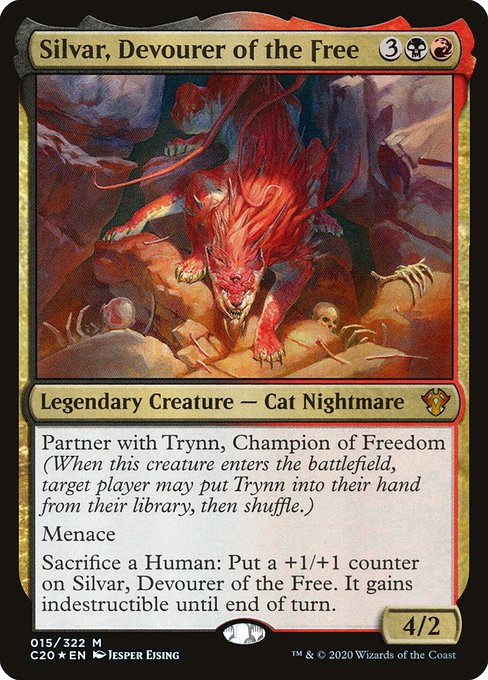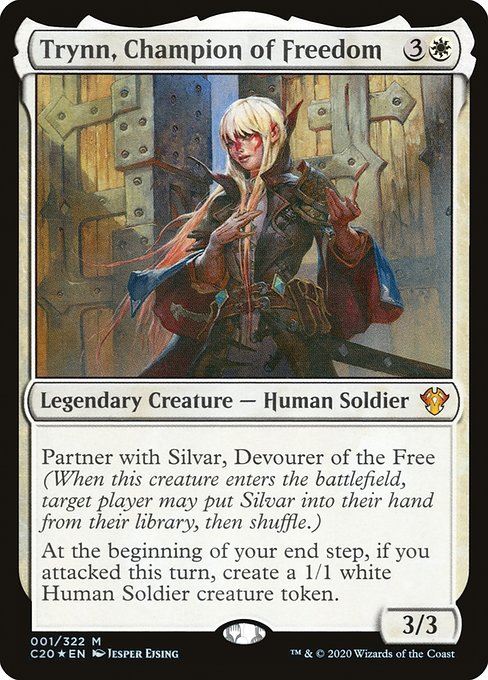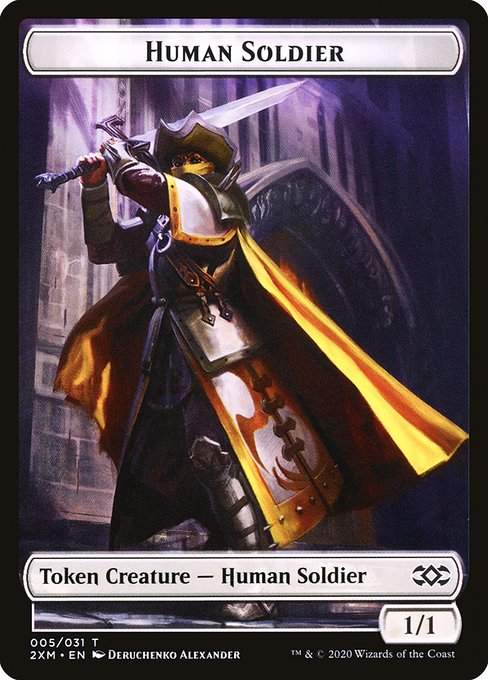Silvar, Devorador dos Livres
Criatura Lendária — Felino Pesadelo
Parceiro de Trynn, Campeã da Liberdade (Quando esta criatura entra no campo de batalha, o jogador alvo pode colocar Trynn na própria mão do próprio grimório e, em seguida, embaralhar.)
Ameaçar
Sacrifique um Humano: Coloque um marcador +1/+1 em Silvar, Devorador dos Livres. Ele ganha indestrutível até o final do turno.
Ameaçar
Sacrifique um Humano: Coloque um marcador +1/+1 em Silvar, Devorador dos Livres. Ele ganha indestrutível até o final do turno.
4/2
standard
future
historic
gladiator
pioneer
explorer
modern
legacy
pauper
vintage
penny
commander
brawl
alchemy
paupercommander
duel
oldschool
premodern
Rulings
Both commanders start in the command zone, and the remaining 98 cards of your deck are shuffled to become your library.
You can activate Silvar’s last ability even if it already has indestructible. It’ll still get a +1/+1 counter.
“Partner with [name]” represents two abilities. The first is a triggered ability: “When this permanent enters the battlefield, target player may search their library for a card named [name], reveal it, put it into their hand, then shuffle their library.”
If your Commander deck has two commanders, you can only include cards whose own color identities are also found in your commanders’ combined color identities. If Haldan and Pako are your commanders, your deck may contain cards with blue, red, and/or green in their color identity, but not cards with white or black.
A creature with a “partner with” ability can’t partner with any creature other than its designated partner. Losing a partner ability during the game doesn’t cause either to cease to be your commander.
The second ability represented by the “partner with [name]” keyword modifies the rules for deck construction in the Commander variant and has no function outside of that variant. If a legendary creature card with “partner with [name]” is designated as your commander, the named legendary creature card can also be designated as your commander.
Trynn’s ability checks only whether you declared an attacking creature during the turn. It doesn’t trigger once for each such creature, and it doesn’t check whether any attacking creatures dealt damage.
The triggered ability of the “partner with” keyword still triggers in a Commander game. If your other commander has somehow ended up in your library, you can find it. You can also target another player who might have that card in their library.
Note that the target player searches their library (which may be affected by effects such as that of Stranglehold) and that the card they find is revealed, even though these words aren’t included in the ability’s reminder text.
Once the game begins, your two commanders are tracked separately. If you cast one, you won’t have to pay an additional the first time you cast the other. A player loses the game after having been dealt 21 damage from one of them, not from both of them combined. Command Beacon’s effect puts one into your hand from the command zone, not both.
You can activate Silvar’s last ability even if it already has indestructible. It’ll still get a +1/+1 counter.
“Partner with [name]” represents two abilities. The first is a triggered ability: “When this permanent enters the battlefield, target player may search their library for a card named [name], reveal it, put it into their hand, then shuffle their library.”
If your Commander deck has two commanders, you can only include cards whose own color identities are also found in your commanders’ combined color identities. If Haldan and Pako are your commanders, your deck may contain cards with blue, red, and/or green in their color identity, but not cards with white or black.
A creature with a “partner with” ability can’t partner with any creature other than its designated partner. Losing a partner ability during the game doesn’t cause either to cease to be your commander.
The second ability represented by the “partner with [name]” keyword modifies the rules for deck construction in the Commander variant and has no function outside of that variant. If a legendary creature card with “partner with [name]” is designated as your commander, the named legendary creature card can also be designated as your commander.
Trynn’s ability checks only whether you declared an attacking creature during the turn. It doesn’t trigger once for each such creature, and it doesn’t check whether any attacking creatures dealt damage.
The triggered ability of the “partner with” keyword still triggers in a Commander game. If your other commander has somehow ended up in your library, you can find it. You can also target another player who might have that card in their library.
Note that the target player searches their library (which may be affected by effects such as that of Stranglehold) and that the card they find is revealed, even though these words aren’t included in the ability’s reminder text.
Once the game begins, your two commanders are tracked separately. If you cast one, you won’t have to pay an additional the first time you cast the other. A player loses the game after having been dealt 21 damage from one of them, not from both of them combined. Command Beacon’s effect puts one into your hand from the command zone, not both.
Rulings
Both commanders start in the command zone, and the remaining 98 cards of your deck are shuffled to become your library.
You can activate Silvar’s last ability even if it already has indestructible. It’ll still get a +1/+1 counter.
“Partner with [name]” represents two abilities. The first is a triggered ability: “When this permanent enters the battlefield, target player may search their library for a card named [name], reveal it, put it into their hand, then shuffle their library.”
If your Commander deck has two commanders, you can only include cards whose own color identities are also found in your commanders’ combined color identities. If Haldan and Pako are your commanders, your deck may contain cards with blue, red, and/or green in their color identity, but not cards with white or black.
A creature with a “partner with” ability can’t partner with any creature other than its designated partner. Losing a partner ability during the game doesn’t cause either to cease to be your commander.
The second ability represented by the “partner with [name]” keyword modifies the rules for deck construction in the Commander variant and has no function outside of that variant. If a legendary creature card with “partner with [name]” is designated as your commander, the named legendary creature card can also be designated as your commander.
Trynn’s ability checks only whether you declared an attacking creature during the turn. It doesn’t trigger once for each such creature, and it doesn’t check whether any attacking creatures dealt damage.
The triggered ability of the “partner with” keyword still triggers in a Commander game. If your other commander has somehow ended up in your library, you can find it. You can also target another player who might have that card in their library.
Note that the target player searches their library (which may be affected by effects such as that of Stranglehold) and that the card they find is revealed, even though these words aren’t included in the ability’s reminder text.
Once the game begins, your two commanders are tracked separately. If you cast one, you won’t have to pay an additional the first time you cast the other. A player loses the game after having been dealt 21 damage from one of them, not from both of them combined. Command Beacon’s effect puts one into your hand from the command zone, not both.
You can activate Silvar’s last ability even if it already has indestructible. It’ll still get a +1/+1 counter.
“Partner with [name]” represents two abilities. The first is a triggered ability: “When this permanent enters the battlefield, target player may search their library for a card named [name], reveal it, put it into their hand, then shuffle their library.”
If your Commander deck has two commanders, you can only include cards whose own color identities are also found in your commanders’ combined color identities. If Haldan and Pako are your commanders, your deck may contain cards with blue, red, and/or green in their color identity, but not cards with white or black.
A creature with a “partner with” ability can’t partner with any creature other than its designated partner. Losing a partner ability during the game doesn’t cause either to cease to be your commander.
The second ability represented by the “partner with [name]” keyword modifies the rules for deck construction in the Commander variant and has no function outside of that variant. If a legendary creature card with “partner with [name]” is designated as your commander, the named legendary creature card can also be designated as your commander.
Trynn’s ability checks only whether you declared an attacking creature during the turn. It doesn’t trigger once for each such creature, and it doesn’t check whether any attacking creatures dealt damage.
The triggered ability of the “partner with” keyword still triggers in a Commander game. If your other commander has somehow ended up in your library, you can find it. You can also target another player who might have that card in their library.
Note that the target player searches their library (which may be affected by effects such as that of Stranglehold) and that the card they find is revealed, even though these words aren’t included in the ability’s reminder text.
Once the game begins, your two commanders are tracked separately. If you cast one, you won’t have to pay an additional the first time you cast the other. A player loses the game after having been dealt 21 damage from one of them, not from both of them combined. Command Beacon’s effect puts one into your hand from the command zone, not both.
Your collection? Your decks?
Want to manage your collection and/or create decks?


 0
0
 0.75€
0.75€

